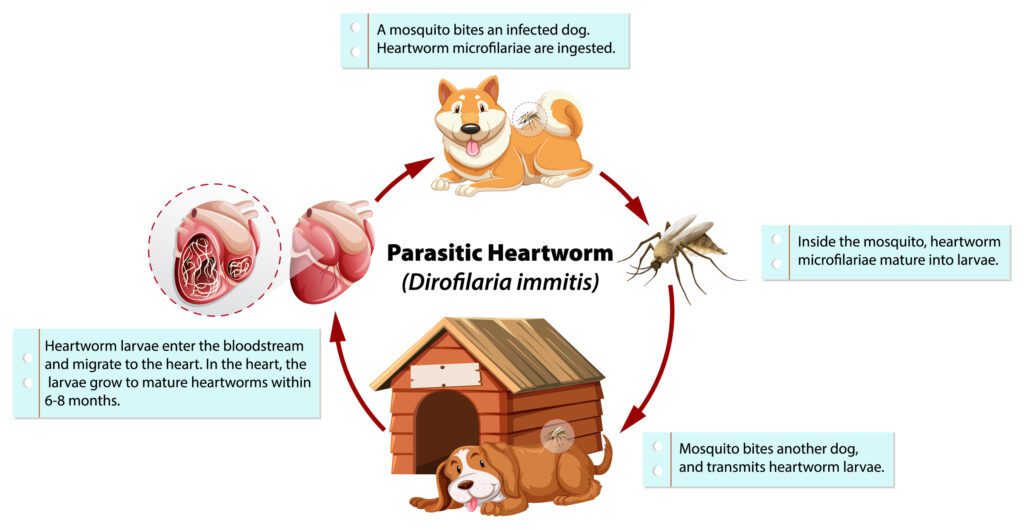Written By: Dr. Allison Valentijn
What is heartworm disease and how can my pet get it?
Heartworms, also known as Dirofilaria immitis, are parasites that are transmitted by mosquitoes. These parasites are found across the continental United States, Hawaii, and Puerto Rico. Dogs are a natural part of the heartworm life cycle, so they are highly susceptible to infection. Cats, ferrets, and other pets may also be infected, but they are less suitable hosts for the heartworms. This means that they may not carry as high as a worm burden as dogs, but they can still experience significant disease.
The mosquito carries immature heartworms in its body as it goes from animal to animal and feeds on their blood. When the mosquito bites an animal that is already infested with heartworms, the mosquito becomes infected and then transmits the worms to the next animal it bites. Once inside its new host, the immature worms travel through the muscle into the bloodstream toward the heart and lungs. They finally reach the lungs about two to four months after transmission. Eventually, the worms may invade the large chambers of the heart. When they first reach the heart and lungs, the worms are only an inch long, but they will continue to grow and mature. Female worms can reach up to 12 inches in length.

What are the signs of heartworm disease?
Signs of heartworm disease are different in cats and dogs. When a dog is first infected with heartworms, they may not show any symptoms right away. Once the worms start to mature in the lungs, the dog may acquire a mild, persistent cough and be more reluctant to play or go on walks. They may be more tired after moderate activity and breathe faster than normal, even when resting. Some dogs may even faint or become disoriented after exercise. As the disease progresses, they become lethargic, have a decreased appetite, and begin to lose weight. Eventually, the dog can develop heart failure and start to accumulate fluid in the abdomen, giving them a pot-bellied appearance.
Cats are also unlikely to show symptoms early in the course of infection. They may develop a strong inflammatory reaction to the immature worms in the lungs, resulting in a clinical syndrome called heartworm-associated respiratory disease, or HARD. This is characterized by persistent coughing, rapid breathing, wheezing, and difficulty breathing. Vomiting can also occur. Unlike dogs, cats are less likely to develop heart failure from this disease. However, fragments from injured or dying worms that lodge in the blood vessels can lead to abrupt respiratory distress and even sudden death.
Some dogs that have a large worm burden can develop physical blockages in the bloodstream, obstructing blood flow to important organs. This is a life-threatening form of heartworm disease called caval syndrome which requires emergency surgery. Signs include sudden onset of lethargy, weakness, pale gums, and dark bloody or coffee-colored urine. Caval syndrome is rare in cats.
How is heartworm disease diagnosed?
There are multiple tests used to screen for and diagnose heartworm disease. Dogs should be tested prior to starting any preventative therapy, six months after starting preventatives, and annually thereafter. A small blood sample is collected from your pet and used for a rapid, highly-sensitive antigen test. This looks for proteins made by the female heartworms in the bloodstream. A microfilaria blood test can be added to look for the worms themselves under the microscope. The earliest an infection can be detected using either of these blood tests is about 5-6 months following transmission of the heartworms. Since cats typically have a lower number of worms, your veterinarian may add an antibody blood test to look for signs of infection.
If your pet has a positive heartworm test, additional diagnostics may be performed, such as chest x-rays and echocardiography. These tests look at the heart and lungs to determine the extent of disease.
What is the treatment for heartworm disease?
In your pet, there will be both immature and adult heartworms, which are treated in different ways. The immature worms have a symbiotic relationship with a bacteria called Wolbachia. This means that the worms cannot live without these special bacteria. An antibiotic called doxycycline is given to kill the bacteria and thereby reduce the number of immature worms. In addition, a macrocyclic lactone is used to directly kill the immature worms and prevent new infections from occurring. Finally, an injectable drug called melarsomine is used to kill the adult worms. The American Heartworm Society recommends a three-injection protocol for melarsomine. This means that your pet will receive two injections of melarsomine one month apart, and the third injection will occur 24 hours after the second injection.
As the worms die, they trigger a strong inflammatory response from the body. Your veterinarian may prescribe steroids to reduce this inflammation. The dead worms can also get stuck in the bloodstream and obstruct blood flow to important organs. This is called thromboembolic disease and it can be fatal. Because the risk of thromboembolic disease is significantly increased with exercise and excitement, it is extremely important that your dog be strictly activity restricted during the entire treatment period and up to two months after their last melarsomine injection.
Cats are special! Due to the lower worm burden, melarsomine injections are not usually recommended in cats. Your cat should still be placed on a macrocyclic lactone as well as a steroid.
If your pet develops caval syndrome, they require emergency surgery to remove the worms.
How can I prevent heartworm disease in my pet and my community?
Heartworm disease is easily preventable! There are multiple heartworm preventatives available. These contain macrocyclic lactones (such as ivermectin, moxidectin, or selamectin), which target heartworms in the body before they become fully mature. Many heartworm preventatives also cover other diseases, such as gastrointestinal parasites. Oral and topical formulations should be given every 30 days. There are also injectable versions which can be given by your veterinarian every 6 or 12 months. Your puppy or kitten can be started on heartworm prevention as soon as 8 weeks old. If your pet is older than 7 months, they should be tested for heartworm disease prior to starting preventatives. We recommend giving heartworm prevention year-round.
If your area is high-risk, you can also take steps to reduce the number of mosquitoes and decrease your pet’s exposure. These include removing or treating standing water sources, applying insecticidal sprays or fogs, and limiting outdoor activity during peak mosquito feeding times. There are also insect repellants and ectoparasiticides that can be applied to your pet. Remember, you should still give your pet their heartworm preventatives!
Where can I go to look for more information?
Here are some great resources to learn more about heartworm disease.
- American Heartworm Society. https://www.heartwormsociety.org/
- Companion Animal Parasite Council. “Heartworm.” https://capcvet.org/guidelines/heartworm/
- Noack et al. “Heartworm disease – Overview, intervention, and industry perspective.” International Journal for Parasitology: Drugs and Drug Resistance, 2021. https://www.sciencedirect.com/science/article/pii/S2211320721000142?via%3Dihub

